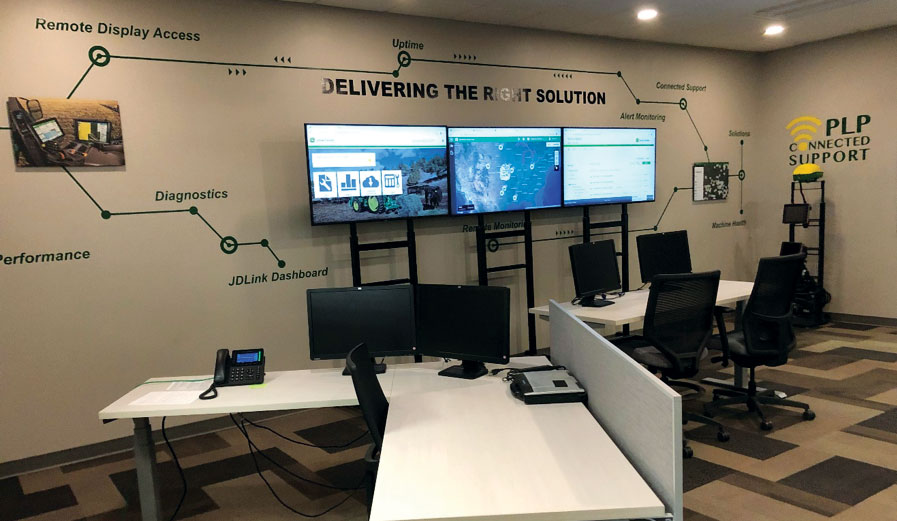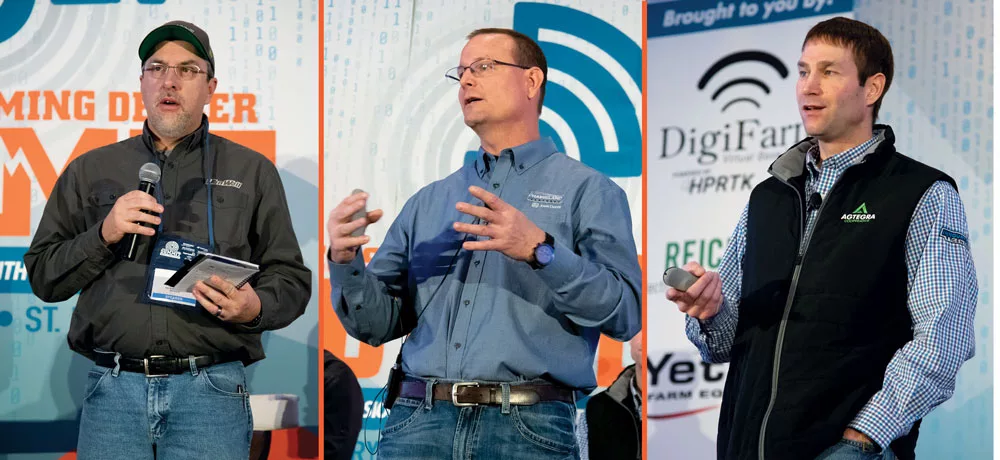Pictured Above: Scott Meldrum, Integrated Solutions Manager, Van Wall Equipment, Perry, Iowa. – Jeff Allison, Precision Farming Manager, PrairieLand Partners, Hutchinson, Kan. – Lance Larsen, Precision Service Coordinator, Agtegra, Aberdeen S.D.,
The ag industry is in the midst of a labor shortage, and precision ag is no different: one speaker at the 2020 Precision Farming Dealer Summit says one study shows the average burnout rate on a precision specialist is 18 months. There’s never a been a more important time to employ management practices that keep retention high and support the strengths of your precision staff. And sometimes that boils down to something as small as a supportive word or regular sit-downs to figure out their goals.
Bringing together 3 unique perspectives, Scott Meldrum (Integrated Solutions Manager, Van Wall Equipment) Lance Larsen (Precision Service Coordinator, Agtegra) and Jeff Allison (Precision Farming Manager, PrairieLand Partners) share how their companies properly train and maintain a team of ideal employees.
Onboarding: Out with the Old, In with the New
There’s a new, younger generation of employees arriving in precision ag, and, along with them, there needs to come a new way of looking at onboarding. Scott Meldrum notes the old-school “trial by fire” method, including the 4 tools he was given when he first started:
- An old flip phone with a recycled number from a previous employee
- Keys to the oldest truck in the fleet
- A printed-out list of contacts
- And a sarcastic “good luck” as his training ended
But as times have changed, the onboarding process has gotten a critical look, and Meldrum explains a few of his methods for improving what was once a nerve-wracking process for new hires. The first step begins in the interview, by clearly outlining for a potential hire exactly what comes with a position in precision ag.
5 Tips for Onboarding Precision Employees
- Be clear in interviews on what “precision farming” means
- Introduce them to staff face-to-face
- Give them a mentor
- Sit them down one-on-one, then listen
- Remember to say “thank you”
“Precision farming is such a broad term,” says Meldrum, “that what a recent graduate might think precision farming means might not be anything like what you are actually expecting of them. They need to know, so that you’re getting the right person.”
Meldrum also makes a point to stick with a new hire beyond teaching them how to punch in their first day; do not toss them in the deep end too soon. This means teaching a new hire what to expect in the first 2 weeks and taking them around their location to meet each staff member face-to-face. Managers should set reminders to regularly call a new hire and ask how things are going, figure out if there are any pain points and how to address them. As Meldrum puts it, “You need to make sure they’re not curled up in the corner sucking their thumb, saying, ‘What did I get myself into?’”
“If you listen carefully enough, your staff will tell you what’s going well, what they like and eventually they’ll tell you where they want to go at the dealership…” – Scott Meldrum, Van Wall Equipment
Reimagining the tools a new hire gets is another key to improve their success in a dealership. Unlike the short, barebones list of tools Meldrum got, he recommends padding the list to ease the onboarding process, starting with a mentor. Hiring managers are a good resource for talking about major hurdles: but for little things like finding where the pens are, an assigned, seasoned mentor can help redirect some of the smaller questions that a hiring manager doesn’t necessarily have to be the first point of contact for.
When it comes to keeping a good hire, communication is key. Meldrum recommends regular, in-person sit-downs to get a real feeling for how an employee views their future at the dealership. “When we go to sit down with them,” says Meldrum, “I don’t talk. I listen. If you listen carefully enough, your staff will tell you what’s going well, what they like and eventually they’ll tell you where they want to go within the dealership.” And the same goes for asking about the direction the department is taking. Taking honest feedback on how seasoned employees perceive what’s happening in the dealership can not only be a helpful resource for management but can go a long way in making an employee feel heard and valued,” he says.
Ending on a positive note is coincidentally Meldrum’s final piece of advice. He makes a conscious effort to end every conversation with his specialists by thanking them for what they do. “It’s the little things like that. If you thank an employee, they appreciate it, and I think they tend to stick around a bit longer,” he says.
Using a Merger to Foster Growth in Your Team & Store
Two dealerships coming together can be a stressful time for managers and a lot can slip through the cracks without careful planning. Jeff Allison from PrairieLand Partners gave tips from the 2 mergers he worked on in 2019 (that gave the dealership 15 stores and 450 employees) and highlighted how they were actually a positive experience for his team.
One thing that immediately brought his people together was combining the operating systems that were used for a streamlined work environment. Among all 15 stores, different business systems to compile the dealership’s data, meaning that the first 5 days of business following the merger, everyone used paper and pencil to get their work done.
“We can’t be afraid to let our precision staff move into different areas. It takes the knowledge that we build and disperses it to other departments. It can be a big win in the sales department…” – Jeff Allison, PrairieLand Partners
A major challenge that comes from dealer mergers is an increased area of responsibility. Allison was looking at 47 counties that he needed to service. “Looking back, I remember having 9 precision specialists scattered over 15 locations, trying to cover acres,” says Allison. “Neighboring dealerships are now overlapping with our coverage and that maybe affects where certain employees work.”
As a result, a major goal Allison and his team had when connecting these different stores was to ensure the customers the service they were used to was not going to change. “We wanted to make this a seamless transition. We wanted to make our customers feel like they still had that resource no matter what logo was on an employee’s shirt.”
Mergers are also a good time to improve on existing systems, while things are still moving and primed for change. Allison and his team were able to implement a series of changes to existing positions to better optimize their service. For example, they were able to move a product specialist, an employee to focus on product and product demonstrations, into a successful role in the sales department. On the surface, it didn’t look like a good fit. “He’s technically minded. He wanted to be hands-on. ‘Don’t put me in an office, I want to be out in the shop’, he said. That’s what he thrived on.”
“Just throwing employees into the fire, they run into a lot of roadblocks and obstacles that hinder them. They experience that failure, and that’s where a lot of the burnout has come from…” – Lance Larsen, Agtegra
But Allison explains how that very same specialist ended up bringing a knowledge of precision ag to the sales side of the dealership that he believes is crucial to success. “We can’t be afraid to let our precision staff move into different areas,” he says. “It takes the knowledge that we build and disperses it to other departments. It can be a big win in the sales department.”

PrairieLand Partners’ “war room” gives staff the ability to closely analyze their customers’ precision data and use it as effectively as possible.
Allison also had the opportunity to create a Connected Support Center, where he placed a precision specialist to stay connected to precision data coming in from customers and their equipment. He calls it his “war room” for its ability to connect to anything and everything. One way PrairieLand Partners uses the data it collects is through its “field command program,” a precision system backed by Premier Crop. The dealership is able to give data gathered from its customers to an agronomist, who analyzes and compiles it into reports for farmers to pay for and use on
their operations.
It’s impossible to perfect the art of merging, however. Allison admits to losing some key steps along the way, such as really digging into the strengths of oncoming specialists who might want to try other positions. “You’re bringing in seasoned guys who maybe have been working in certain capacities for several years and want to try out their strengths in other things,” says Allison. “I wish I’d gotten a better idea of what they’d like to do and how they might flourish.”
Learn More
-
20 Employee Training & Retention Tips for Precision Ag Staff
A diverse group of dealers divulge their secrets to motivating new employees, making the most of training opportunities and why an ‘open book’ approach can be a competitive advantage.



![[Technology Corner] A Big Step Forward for Interoperability & Data Sharing](https://www.precisionfarmingdealer.com/ext/resources/2025/12/12/A-Big-Step-Forward-for-Interoperability--Data-Sharing.webp?height=290&t=1765565632&width=400)


